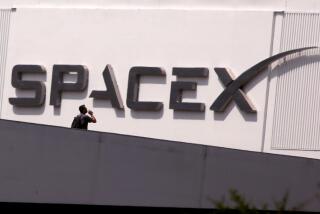Chip Factories Envisioned for South of Border
SAN FRANCISCO — American investors and Mexican officials unveiled an ambitious plan Wednesday for an industrial park in Mexico on the California border to entice computer chip companies to build multibillion-dollar factories there instead of exporting production to Asia.
State-of-the-art factories on the 15-square-mile site in Mexicali, about 120 miles east of San Diego, could create as many as 100,000 high-tech jobs in 10 years, said Daniel Hill, chairman of Silicon Border Development, the private firm that intends to build the industrial park.
To lure would-be tenants, Mexican President Vicente Fox has agreed to waive taxes for 10 years for companies that move into the park, and the federal and state governments will offer other financial incentives and assistance, Hill said.
Silicon Border Development said it planned to spend $300 million to $400 million to build the park in Mexicali, the state capital of Baja California. Construction is expected to begin in early 2005 after the land is purchased, said Ron Jones, Silicon Border’s chief executive.
Jones said the funding would come from “industrial investors” whom he declined to identify.
“We see no reason that operations can’t be set up in Mexico and have all the cost advantages of Asian countries and compete equally or even better than them,” said Jones, who spent 12 years in South Korea and Thailand working with chip firms including Texas Instruments Inc.
Asia is the fastest-growing region for semiconductor fabrication plants, or “fabs,” which typically each cost $2 billion or more to build. Taiwan and China dominate the fab market in Asia; Malaysia, Singapore and South Korea also have chip plants. Virtually every circuit board built today contains chips from Asia.
“We’ve watched how everything’s moving in that direction, and we were worried it may be going too far,” Hill said at a news conference at Semicon West, a semiconductor manufacturing trade show here.
“Semiconductor companies and their customers are increasingly concerned over growing dependence on China,” said Hill, a veteran of National Semiconductor Corp. who spent eight years in Malaysia. With constant military tensions between China and Taiwan, and between North and South Korea, “any issue over there could bring the chip industry to a halt.”
Silicon Border Development hasn’t signed up any tenants, though it says it is close to completing a couple of deals.
Tech firms were once eager to manufacture in Mexico. Hewlett-Packard Co., Lucent Technologies Inc., Solectron Corp. and others opened plants in Jalisco state in the 1990s, but they have since closed or downsized their operations in response to an industrywide excess of production capacity resulting from the recession in the U.S. and elsewhere.
Chalmers Johnson, a retired UC San Diego professor who has closely studied Japanese investment in Mexico, said he was puzzled at the idea of trying to lure tech companies back.
“If you want to invest in Mexico, why go to Baja?” Johnson asked. The highway and rail transportation systems in the U.S. just north of Mexicali are so poor that “it’s more efficient to get on an airplane and go to Taiwan,” he said.
But backers of the project said the region had advantages, including a workforce of 750,000 in Mexicali and an additional 142,000 in neighboring Imperial County in California. Mexicali also boasts a reliable water supply. What’s more, Mexico has 11 free-trade agreements with Latin American countries and the European Union and is finalizing one with Japan, said Mexican Minister of Economy Fernando Canales.
“The industry is growing,” Canales said. “Markets are starving for new products, and we want to be a part of it.”
The hope is to attract not only the semiconductor fabs but also the entire supply chain of chip manufacturing -- from silicon wafer producers to facilities where wafers are cut up into chips and tested to plants where microprocessors are installed on circuit boards.
“It would be like in Japan, where an entire city grows up to support a Toyota factory,” Jones said.
A high-tech injection south of the border would be welcome news for Mexico’s hard-hit maquiladora export factory sector, which was hammered by the slowdown in the U.S. economy. The sector shed more than a quarter of a million workers, or nearly 18% of its job base, between 2000 and 2003.
Manufacturing employment has perked up in recent months as Mexico has finally begun to feel the stirrings of recovery. But the continued exodus of industries such as textiles and apparel to lower-cost countries such as China have made it clear that Mexico can no longer compete on the basis of cheap labor alone.
The industry’s long-term prosperity, experts say, depends on Mexico’s ability to capitalize on its proximity to the United States with rapid-fire turnaround that Asia can’t match, while moving up the value chain to produce more-complex products that aren’t as dependent on rock-bottom factory wages.
Tony Ramirez, executive vice president of Made in Mexico Inc., a San Diego-based firm that helps U.S. companies set up operations south of the border, said virtually none of the inquiries he had received lately were from makers of sophisticated products: “We haven’t seen anything substantially high tech.”
But Jose Enriquez, sales and marketing director for American Industries, a relocation consulting firm based in Chihuahua, Mexico, noted that Honeywell International Inc. and other high-tech firms were beginning to make investments in Mexico.
“Companies are realizing that China isn’t the only place to invest,” Enriquez said.
Advanced Micro Devices Inc., the largest supplier of flash memory chips and the second-largest maker of personal computer microprocessors, said it would consider Mexicali.
“Whenever we look to expand our manufacturing capabilities, we will look at all the possibilities, so I think this would be on the list,” AMD spokesman David Kroll said.
Jones reported from San Francisco and Dickerson from Mexico City.






